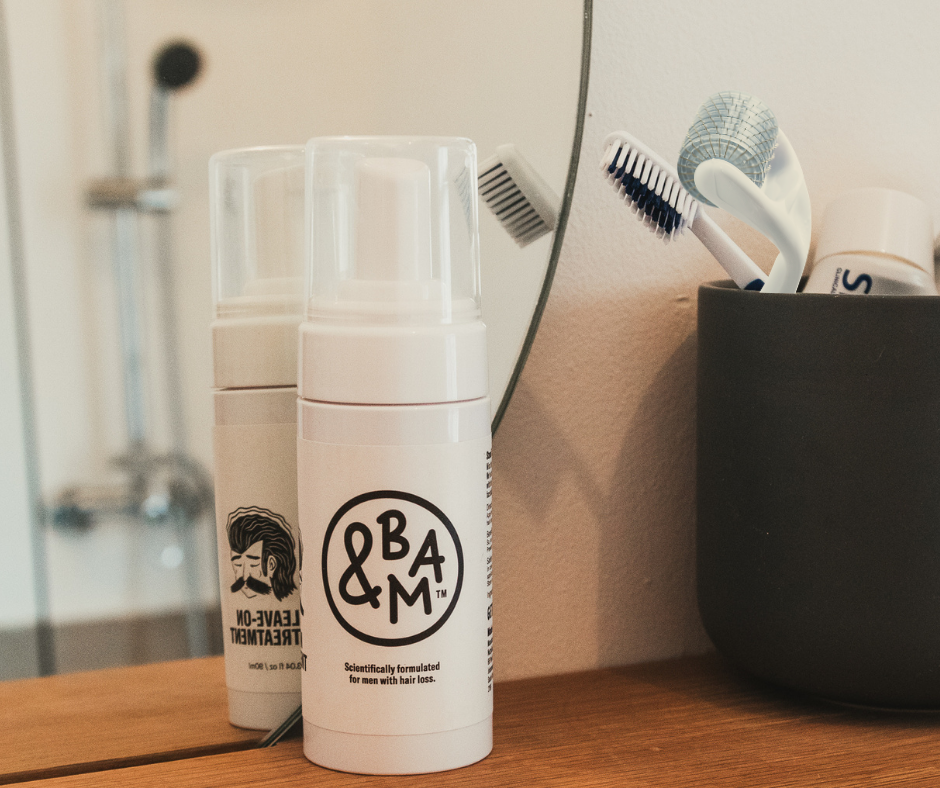You want me to do what? That’s probably the thought that passes through most guys’ heads when they first read about micro-needling. The thing is there’s some surprising science behind this strange practice which we’ll explore in this post.
First, let’s unpack exactly what a dermaroller is, how micro-needling is performed, how it works and then, if it should be a key addition to your current hair loss artillery.
Easily mistaken for a miniature torture tool, a dermaroller is a manual hand-held device that is made up of multiple tiny metal (usually titanium alloy) needles that is designed to be rolled over the skin to create minor punctures in the epidermis and dermis, the top two layers of the skin. A standard at-home dermaroller has 192 needles, set on a rotating head with the needle length ranging from as little as 0.2mm to 2.0mm long.
The device is used by manually rolling it over the desired area (in our case, the scalp), applying a gentle but firm pressure to the skin with a back-and-forth movement to ensure the entire area has been treated. Micro-needling was traditionally performed by trained professionals, but in recent years at-home devices have become available and legions of internet-informed, aesthetic health hackers have started doing their own treatments. Depending on the type of roller you are using, the needle length, frequency of use and ultimately the effect desired, you will see different short- and long-term effects from micro-needling. We’ll be focusing on scalp micro-needling, but the technique can be used for various aesthetic purposes throughout the body.
The acute effects of micro-needling are not usually pleasant or particularly aesthetically pleasing. After properly using a 1.5mm 192-pin roller (the type most often used and recommended by hair loss researchers for scalp micro-needling) you will see pin-point bleeding or oozing of the scalp and there may be some redness and tenderness over the treated area.1,2 These effects are usually short-lived, and your scalp should be back to normal within a day or two. Some clients find the procedure quite painful to perform and so make using of a topical numbing agent prior to using the treatment. This will not reduce the benefits of the treatment and is a matter of preference for each individual. Following micro-needling, we recommend not using any topical hair loss treatments for approximately 24 hours to allow the scalp to begin the healing process without any additional medications or compounds which could potentially cause further irritation to the scalp. The procedure should be repeated at weekly intervals in order to ensure the benefit of the treatments are realised without constantly causing minor injuries to your scalp.1,2 The device and your scalp should be cleaned (before and after) with an alcohol-based disinfectant to ensure that no infections are introduced into the scalp by the needles.
Redness? Tenderness? Infections? Bleeding?? At this stage if you’re even more skeptical than you were when you started this article then we don’t blame you. But we’re here to explain the method behind the madness. As we explored in our blog post about minoxidil, one of the pathways involved in hair loss is the multitude of growth factors responsible for the promotion of hair growth. These growth factors lengthen the anagen phase (growth phase) of the hair cycle which then results in longer, thicker and stronger hair. By making multiple minor punctures in the scalp, micro-needling causes vasodilation (thereby increasing the scalp’s blood supply) and results in an increase of the various growth factors (VEGF, IGF-1, FGF etc) thus keeping your hair in the growth phase for longer and promoting a fuller head of hair.2,3
It has also been shown that using topical minoxidil (and possibly topical finasteride too) in combination with micro-needling may increase the absorption of the medication which then results in even further regrowth, over and above what either the minoxidil or micro-needling can do when used alone.3,4
In the short term, especially when you’re just starting out with micro-needling, the effects of the procedure(s) look pretty undesirable. In the long-term however, micro-needling offers a promising treatment adjuvant to the traditional hair loss medications and should not be ignored by clinicians treating hair loss.
Micro-needling has been shown in multiple trials to offer a significant benefit in conjunction with topical treatment, especially in clients who don’t initially respond to medical hair loss treatments.4,5,6 Although the trials were small in size, the effect sizes were relatively large, showing between 4 and 6 times the amount of growth seen in minoxidil-only treatment.4,5,6 Like any new treatment, there’s always a need for further research and larger scale trials, but we believe micro-needling has a lot to offer to the hair loss community and should be strongly considered in those who’ve failed to respond to initial treatments.
References:

